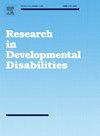Relationship between motor competence and physical activity among children aged 3–6 years at risk for developmental coordination disorder
IF 2.6
2区 医学
Q1 EDUCATION, SPECIAL
引用次数: 0
Abstract
Background
To date, it remains unclear whether young children at risk for developmental coordination disorder (DCD) develop deficits in physical activity participation, and the relationship between motor competence (MC) and physical activity (PA) in these children.
Aim
To evaluate the levels of MC and PA in young children at risk for DCD (rDCD) and to explore the relationship between these two aspects.
Methods and procedures
A total of 124 children with rDCD and 124 typically developing (TD) children aged 3–6 years were selected. Each group included 85 boys and 39 girls. MC was evaluated using the Movement Assessment Battery for Children-2 and the Test of Gross Motor Development-third edition. PA was assessed using the Questionnaire of Parents of Physical Activities of Young Children. MC variables were manual dexterity, aiming and catching, balance, and locomotor skills. PA variables were total PA (TPA), moderate to vigorous PA (MVPA) and sedentary behavior (SB).
Outcomes and results
Children with rDCD had significantly lower scores in manual dexterity, aiming and catching, balance, and locomotor skills compared with TD children (P < 0.05). There was no difference in TPA, MVPA and SB between children with rDCD and TD overall (P > 0.05). Balance, aiming and catching, and locomotor skills in children with rDCD were weakly positively correlated with MVPA (r = 0.197–0.347, P < 0.05). Balance, aiming and catching, and locomotor skills in children with rDCD significantly predicted MVPA (β= 0.219–0.342, P < 0.05).
Conclusions
Young children at risk for DCD do not yet show deficits in physical activity participation. It is still important to develop motor competence in young children at risk for DCD, as this may help them sustain participation in physical activity and avoid early withdrawal.
3-6岁发育性协调障碍风险儿童运动能力与身体活动的关系
背景迄今为止,发育协调障碍(DCD)高危幼儿是否在体育活动参与方面存在缺陷,以及这些幼儿的运动能力(MC)和体育活动(PA)之间的关系仍不清楚。目的评估发育协调障碍高危幼儿(rDCD)的运动能力和体育活动水平,并探讨这两方面之间的关系。每组包括 85 名男孩和 39 名女孩。用儿童运动评估电池-2和粗大运动发育测试-第三版对MC进行评估。幼儿体能活动采用幼儿体能活动家长问卷进行评估。运动能力变量包括手的灵活性、瞄准和捕捉、平衡和运动技能。PA变量包括总PA(TPA)、中度至剧烈PA(MVPA)和久坐行为(SB)。结果rDCD儿童在手部灵活性、瞄准和捕捉、平衡和运动技能方面的得分明显低于TD儿童(P< 0.05)。患有肢体后天障碍的儿童与患有肢体后天障碍的儿童在总运动量(TPA)、中长期运动量(MVPA)和局部运动量(SB)方面总体上没有差异(P> 0.05)。RDCD儿童的平衡、瞄准和捕捉以及运动技能与MVPA呈弱正相关(r = 0.197-0.347, P <0.05)。结论DCD高危幼儿在参与体育活动方面尚未表现出缺陷。对有 DCD 风险的幼儿进行运动能力培养仍然很重要,因为这有助于他们持续参与体育活动,避免过早退出。
本文章由计算机程序翻译,如有差异,请以英文原文为准。
求助全文
约1分钟内获得全文
求助全文
来源期刊

Research in Developmental Disabilities
Multiple-
CiteScore
5.50
自引率
6.50%
发文量
178
期刊介绍:
Research In Developmental Disabilities is aimed at publishing original research of an interdisciplinary nature that has a direct bearing on the remediation of problems associated with developmental disabilities. Manuscripts will be solicited throughout the world. Articles will be primarily empirical studies, although an occasional position paper or review will be accepted. The aim of the journal will be to publish articles on all aspects of research with the developmentally disabled, with any methodologically sound approach being acceptable.
 求助内容:
求助内容: 应助结果提醒方式:
应助结果提醒方式:


